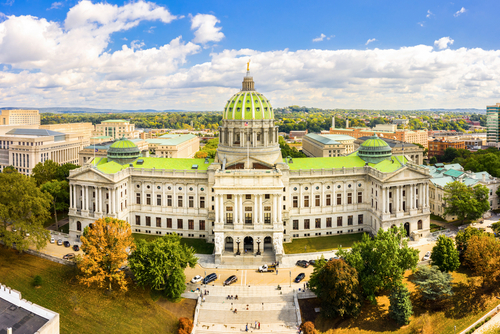
Financial watchdogs who have scrutinized Pennsylvania Gov. Josh Shapiro’s 2024-25 budget say the proposal’s excessive spending will harm the state’s fiscal health by increasing the state’s structural deficit and possibly leading to future tax hikes.
The $48.3 billion budget request the governor unveiled in February represents a 7 percent spending increase over last year’s ongoing general fund spending. Shapiro said his budget plan is balanced and would maintain a surplus of $11 billion at the end of June 2025 without raising taxes.
However, according to Commonwealth Foundation Senior Vice President Nathan Benefield, the governor’s budget would increase the state’s structural deficit to more than $6 billion, emptying the state’s checking account and draining the state’s Rainy Day Fund. Eventually, he said, the budget plan would require the state to implement tax hikes of more than $2,000 per family.
Benefield said Shapiro’s claim of an $11 billion surplus next year is misleading.
“What he really means is there will be $11 billion between what’s in the general fund and the Rainy Day Fund at the end of the year,” he said. “There’s a couple of problems with that. One is it will be $11 billion between those two at the end of the year, but we’re starting with $14 billion at the beginning of the year. The other is that the budget spends $3 billion more than the state has coming in as revenue, creating a deficit.”
That deficit spending forces the state to dip into savings, Benefield said, and lumping the Rainy Day Fund in with the General Fund is not appropriate.
“The Rainy Day Fund is literally created by legislation to be an emergency fund in case there is a recession or a natural disaster or some other issue so the state has reserve funds that can be tapped into,” he said. “The fact that he is simply planning to, in the next few years, drain that reserve, not for an emergency but just for ongoing spending, is very problematic.”
Benefield said the current fiscal year’s budget already operates with a deficit. The proposed budget would add another $4.5 billion in new spending initiatives.
“In the next couple of years, he would drain the entirety of the checking account. And if his plans continue it would require draining the Rainy Day Fund,” Benefield said. “In the end, we’d have a budget deficit with no reserve funds there. His budget plans would require tax increases within just a few years.”
In its most recent report on Pennsylvania’s fiscal health, the Independent Fiscal Office projected that even if spending stays the same over the next several years, the commonwealth will routinely spend more than it brings in. Its forecast shows that without new revenue or spending cuts, the state is on track to eat up its current $12 billion cushion by around 2027.
Attempts to drain the Rainy Day Fund would impact more than the state’s ability to fall back on reserves, it could also impact the state’s credit ratings, lawmakers said.
The Pennsylvania Treasury transferred $900 million to the Rainy Day Fund in November 2023, giving the state enough money to fund the government in an emergency for 48 days. The strength of the state’s reserves was part of the reason that Moody’s Investors Service and S&P Global Ratings revised Pennsylvania’s general obligation bond rating outlook to positive from stable.
State Rep. Seth Grove (R-York), who chairs the House Appropriations Committee, noted that depleting the Rainy Day Fund could cause the Commonwealth’s bond rating to fall, increasing the cost of borrowing. As it stands, Grove said, the Rainy Day Fund is saving taxpayers $100 million in long-term debt costs.
House Republican leaders said the budget ignores the changing face of Pennsylvania, and upends conservative measures to protect the state from future challenges.
“Given the demographic challenges we face with significant growth in the elderly population and contraction in the working-age population, this is not the time to blow through reserves, expand government and introduce new spending initiatives,” Republican House leadership said. “Yet Governor Shapiro is doing all three, including proposing initiatives of more than $2.5 billion identified in his budget as creating new, or expanding current, government programs.”
The governor’s budget request also does not include reforms to the state’s burdensome regulatory and tax structure, which would create jobs, attract investors, and increase tax revenues without increasing tax rates, David N. Taylor, President and CEO of the Pennsylvania Manufacturers’ Association (PMA) wrote in a recent legislative bulletin.
Pennsylvania’s structural budget deficit is driven by the state’s demographics, he noted. “In turn, these dynamics intensify our workforce crisis. The only way to change things in a positive direction is to improve Pennsylvania’s economic competitiveness, which begins with fiscal discipline,” Taylor said.
Emily Greene, Deputy State Director with Americans for Prosperity-PA, agreed.
“Pennsylvanians are asking for many things: better tax rates to compete with neighboring states, less burdensome barriers for small business and entrepreneurs, better educational outcomes and equally important better choices to create opportunities for growth, and broader access to health care options. Unfortunately, the concerns of the people of Pennsylvania were not addressed in the Governor’s budget proposal,” Greene wrote in an op-ed.
Meanwhile, House and Senate committees have been holding budget hearings in advance of the June 30 deadline for when a state budget must be adopted.